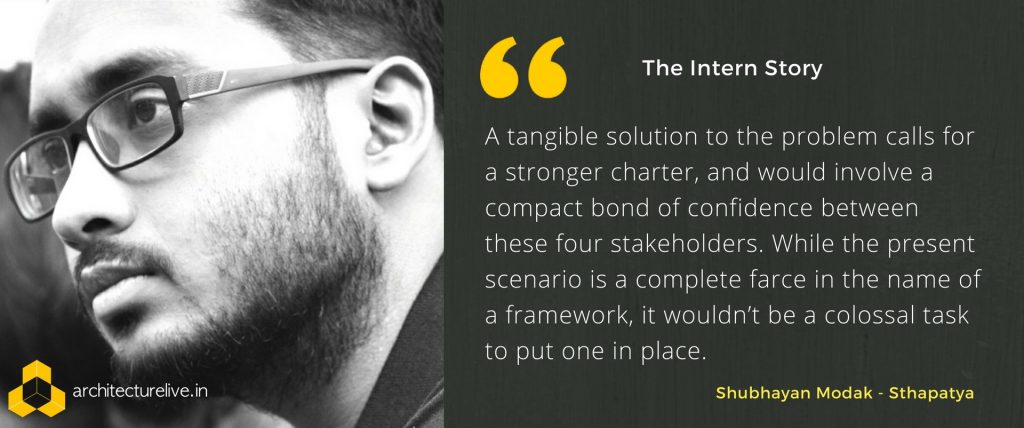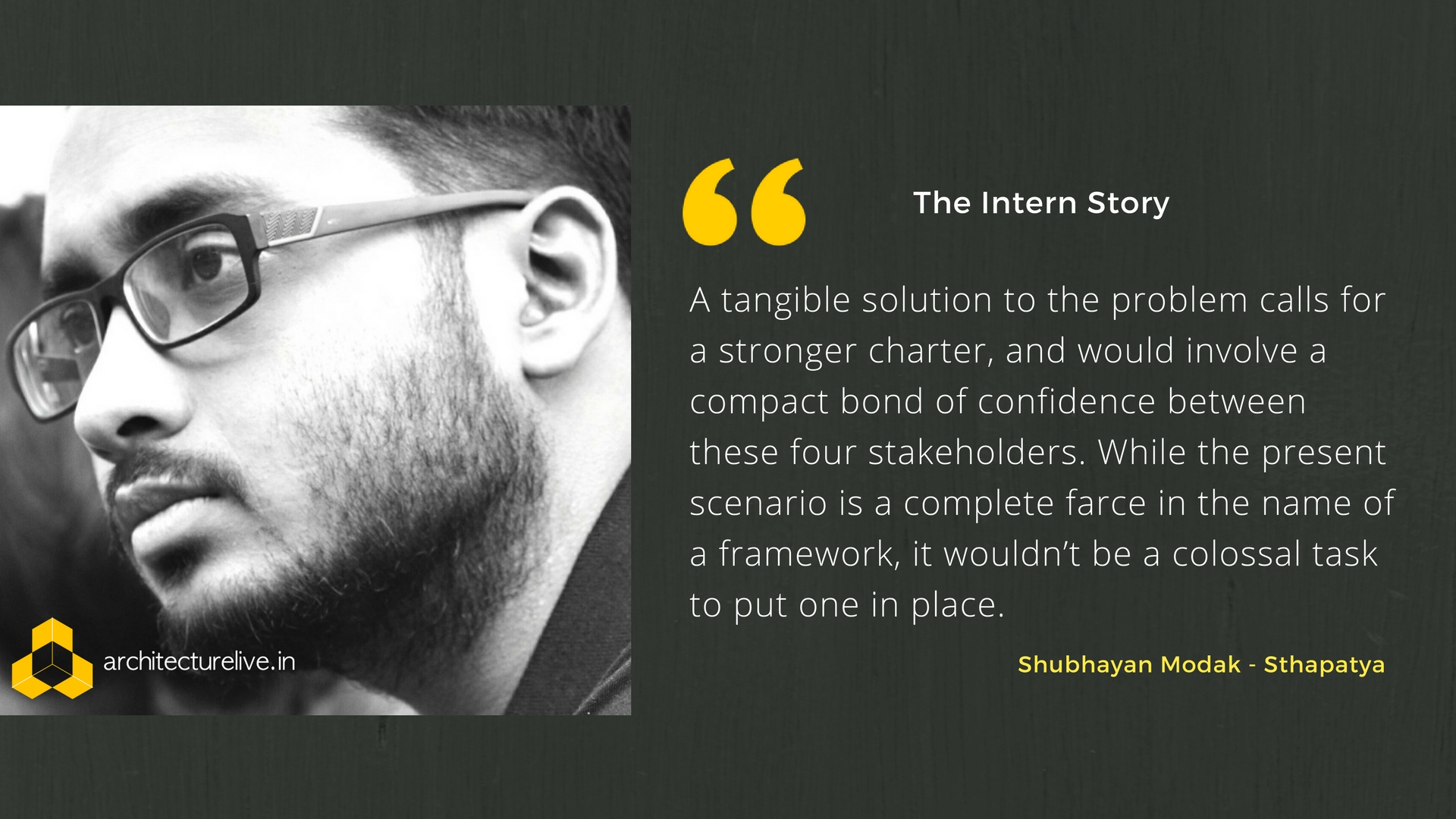Student internship is a quintessential part of an architectural education. However, it is increasingly becoming an unmitigated ordeal for many within the community. Affecting both students and practicing architects, the workforce imbalance and issues of ineptitude have created an unfavourable – and often exploitative – situation.
Inviting the opinions of architects, educators and students, we strive to start a conversation about what can be done to improve this situation. Below, Shubhayan Modak of Sthapatya ponders upon the feasibility of including internships in architectural education.

Overpopulation is an erosive phenomenon. It degrades quality at the cost of quantity and subsequently creates complications which are harder (read ‘almost impossible’) and resource-intensive to resolve. Indian architectural education is facing a comparable situation now; with 467 architecture schools in operation and the common institutional intake upwards of a hundred per batch, it surely isn’t going uphill. Absence of a disciplinary framework, inexperienced staff, as well as irrational teaching methods are resulting in a loss of quality.
With this radical upsurge in numbers, problems such as deteriorating pay scales and internship troubles are popping up. India has hardly ever paid attention to labor laws, and almost every company forces their employees to work harder and for longer hours simply because ‘they are getting paid’. The ones bearing the biggest brunt of this situation are the interns. The youngest of the industry, they always struggle to get their voice heard; low stipends (or none), stressful situations, mental harassment and continued unpaid overtime work are common cases in India. The situation is quite grave and dramatic steps are necessary to curb the problem.
In a typical case, a final year student who is presently interning with an office in Delhi has not been paid her stipend for the last two months. When confronted, the accountant allegedly addressed the intern(s) about how stipend is a voluntary payment, and since the interns were there to learn, they should not have been reliant on the office for their personal expenses. Not only is this highly unethical, but also inhuman. A large number of students travel to new cities for gaining experience, and it is not rational to expect that they will be able to support themselves fully.
Coming back to the broader situation, the four parties involved in this issue are the students, the architecture schools, the professional fraternity and the Council. A tangible solution to the problem calls for a stronger charter, and would involve a compact bond of confidence between these four stakeholders. Given the present framework is a complete farce, it wouldn’t be a colossal task to put a better alternative in its place.
What essential points should such an agenda stress upon? While many would argue that a student-friendly system is necessary, a framework prioritizing any specific side would escalate chances of jeopardy. The possibilities are limited, and have to be introduced by the Council. It should focus on an unprejudiced system with rubrics to be followed for every probable situation.
The Council
The first step for the Council of Architecture would be to stop approving any new institutions, with cancelling the affiliation of sub-par schools being an excellent start. The news of AICTE cancelling the affiliation of 800 engineering institutions pan-India has struck a note in favor of quality education, and it is time the Council follows suit. India has been manufacturing sub-standard students in the last few years, and placing a ban on complete commercialization of education is a must. Following this culling, the Council must also place limits on the student intake for each school.
The Professional Fraternity
All professional practices should be listed, and providing internships must be made mandatory. The minimum number of interns should depend on the physical and financial capacity of the firm, with the number of openings and relevant details being displayed on their website. The most important step would be to draft an ‘Internship Manual’ to be followed by all parties, setting down guidelines regarding nature of work, pay scale, remuneration for overtime, and professional conduct. These guidelines – especially those pertaining to remuneration – would be standardized, and sternly implemented. A set of rules protecting interns from mistreatment and harassment would be an essential part of this manual, and a separate cell dealing with reports of such inconsistencies should be set up to ensure in-depth investigation and swift redressal, preferably within a month from the launch of the grievance.
With a handful of offices in the country providing interns the right balance of work, exposure and entertainment, the rest of the firms should take their example as an inspiration. All offices must take internship applications seriously and no mail must go unanswered, whether it’s an acceptance or a rejection. After an office confirms a candidate for a position, a minimum time of two weeks should be given to the student to decide. No office should demand free labor from any intern with the justification of teaching them the trade; on-time payment as well as satisfactory remuneration for over-time work must be made mandatory.
The Architecture Schools
All institutes should take up the responsibility for guiding their pupils regarding internship. An absence of participation on the part of many institutions is a sad but true phenomenon. Schools should be answerable for placing all students in offices as interns, and there should be continuous monitoring throughout the training period. In case of any discrepancy or grievance from or against the intern, the institution should take the charge in resolving the issue; retreating from responsibilities in such critical times should be regarded as a breach of faith.
The Interns
The youngest of the lot, trainees need to be persistent and willing to learn. They should shed the college (read ‘i-know-it-all’) temperament and be ready to step in knee deep into real practice. Handpicking preferences and working on custom applications is a must. An intern should ask for variety of jobs and should enthusiastically approach even the most uninteresting tasks. Interns should also insist upon getting personal copies of all documents acting as an official agreement, and maintain records of Emails, letters and certificates for addressing all future concerns. No exploitation, ill-treatment or harassment should be withstood and swift protest against any offence is recommended.
However, there is no need of suspicion or mistrust regarding work culture and payments, and one must learn to differentiate between what is an offence and what isn’t. Your boss not paying you or abusing you would be an offence, but demanding a night of work or asking you to put in few hours on a holiday isn’t. Ask for work, raise queries and request site visits, but also be sure to ask for your remuneration if your payment is due. Be modest, but make your voice heard as well. Follow the manual meticulously, but do not use it to twist things in your favour – make your choices wisely and not impulsively.
Internship is an important episode in architectural education, which makes it necessary to formulate a competent supervisory framework. So many deliberations done, words written and debates dusted would mean nothing if the Council sits idle. It has been working with a lax approach for a very long time now, and it is high time they come out of hibernation. Requesting them to act would not produce a result; hence I ask the entire fraternity to demand action from the Council. There should be a charter, and this should not come as paperwork issued by a shadow body from inside an air conditioned room – the process should be comprehensive and all the four parties involved should vigorously contribute. There should be complete trust and reliance amongst these bodies, for the start of anything good requires a foundation of faith.
 Shubhayan Modak is a graduate architect from Dept. of Architecture, Town & Regional Planning, Indian Institute of Engineering Science & Technology, Shibpur. He is the Co-founder and Editor-in-chief of Sthapatya that aims at raising architectural awareness amongst the common public by using local language and colloquial glyphs. Currently working as an architectural correspondent in Delhi, he is passionate about visiting places, and exploring the local rituals, cultures, traditions and people. He has served as the Convenor & Editor-in-chief of Indian Arch ’16, the annual student’s journal of National Association of Students of Architecture, India.
Shubhayan Modak is a graduate architect from Dept. of Architecture, Town & Regional Planning, Indian Institute of Engineering Science & Technology, Shibpur. He is the Co-founder and Editor-in-chief of Sthapatya that aims at raising architectural awareness amongst the common public by using local language and colloquial glyphs. Currently working as an architectural correspondent in Delhi, he is passionate about visiting places, and exploring the local rituals, cultures, traditions and people. He has served as the Convenor & Editor-in-chief of Indian Arch ’16, the annual student’s journal of National Association of Students of Architecture, India.








